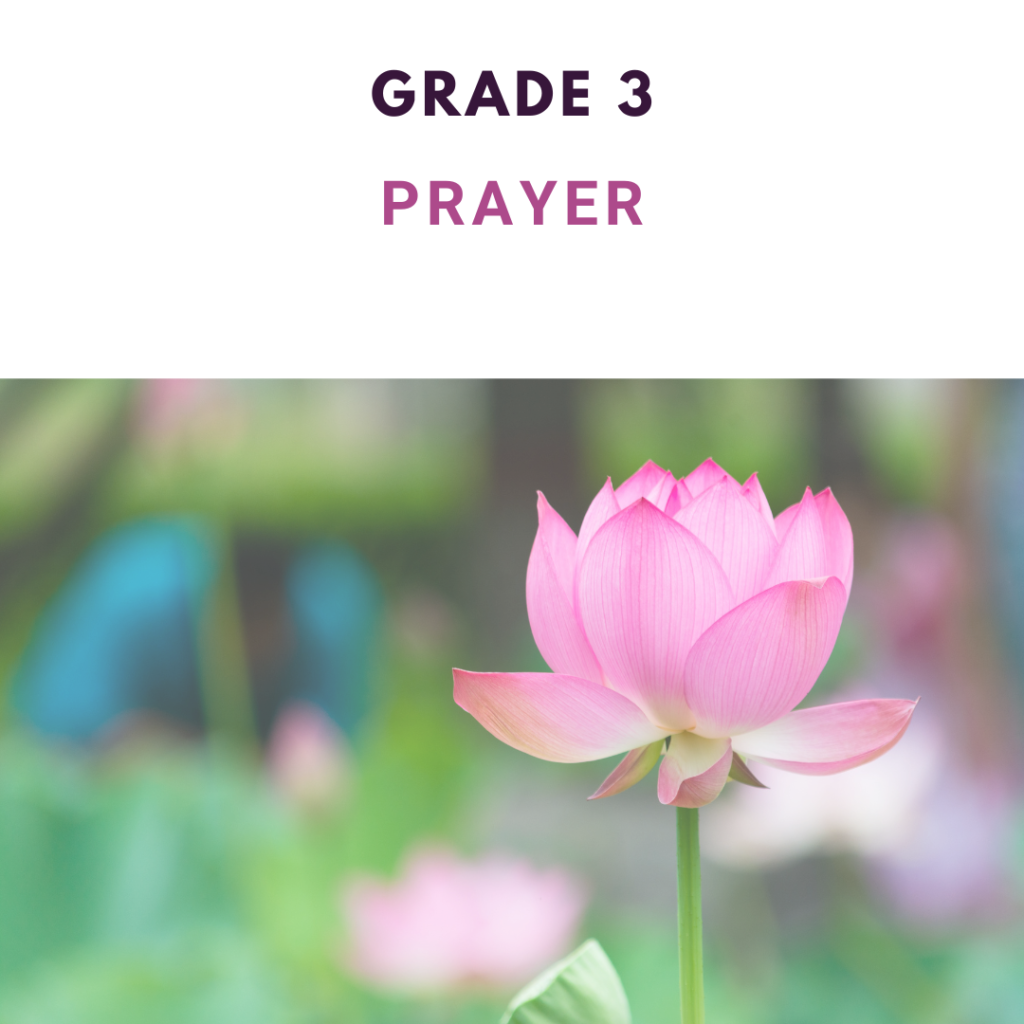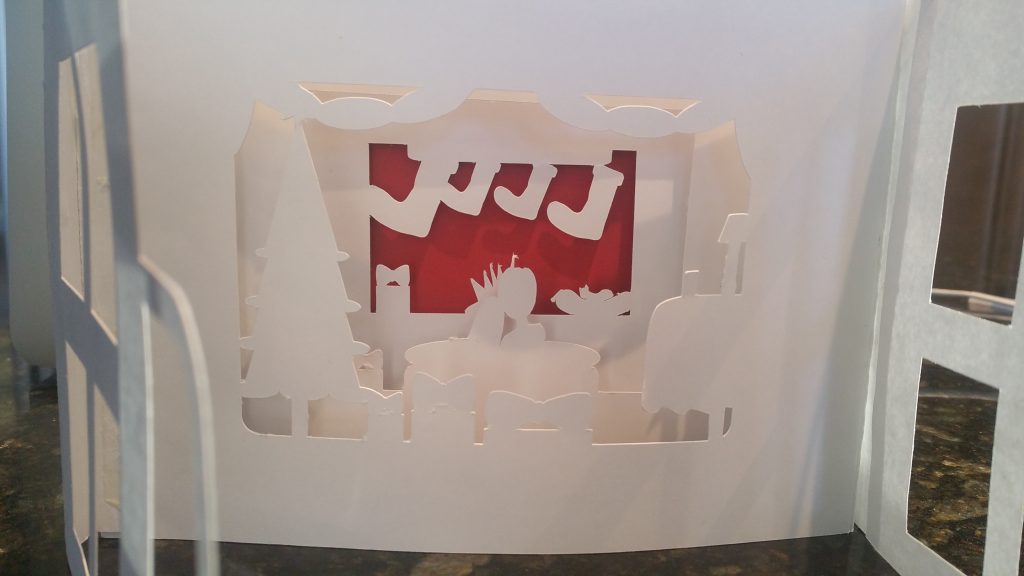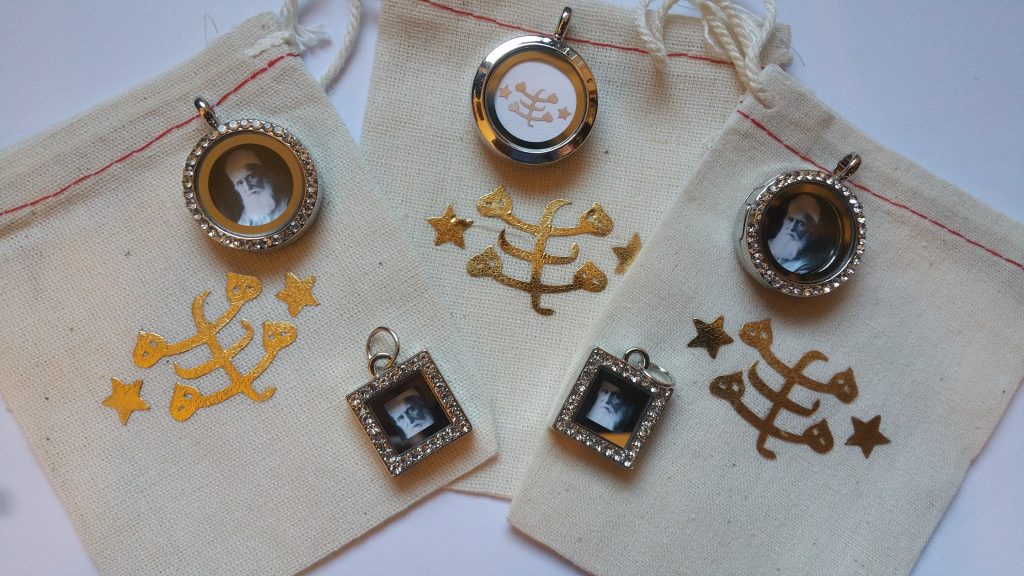
Welcome to lesson 4 . There are 4 prayers to memorize for lessons 4 to 10
The purpose of this lesson is to provide the opportunity to think about the concept of the oneness of God and to recognize that all the Manifestations proclaim the unity of God.
In this lesson, we will learn about Abraham, a Manifestation of God who appeared thousands of years ago to guide His people to an understanding of God’s essential oneness.
We know that God is the Great Bestower and Giver of life. He has created the universe and all that is therein. He is the Source of all that exists. No other force or power can compare with Him. From the beginning of time, God has sent His Manifestations to help humanity understand His oneness. Without Their instructions from age to age, people have often fallen into the worship of idols or spirits or even elements of nature, like the sun, the wind, and the moon. They would give God’s attributes such as love, justice, power and majesty, wisdom, and generosity, to each of these idols or spirits and would worship them as though they were gods themselves that control the world and everything therein.
All the Manifestations of God remind humanity that there is only one God, the All-Glorious, the All-Powerful, Whom we worship, Who lovingly guides us, and whose aid and assistance we seek. Even today, unaware of the new teachings of God brought by Bahaullah, many people have begun to worship different kinds of idols, giving their hearts to the pursuit of wealth, power, and fame. The human heart was created to love, and if it is not filled with the love of God, it will find some object for its affection and adoration. God has created every good thing in this world for us to enjoy. But He wants our hearts to be attached to Him, and Him, alone. In the Hidden Words, Baha’u’llah says:
“O Son of Being! Thy heart is My home; sanctify it for My descent. Thy spirit is My place of revelation; cleanse it for My manifestation.”
Abraham was a Manifestation sent by God several thousands of years ago when many people had forgotten God’s oneness and worshipped idols and powers in nature. Few wanted to listen to the Message brought by Abraham that they should worship the one true God. Alone and without help, He withstood the forces that opposed Him. Though He was exiled from His native land by a king who feared Him, the light of His Message could not be extinguished, and His teachings spread, through His children and their descendants, to many nations.

DOWNLOAD ALL 4 PRAYERS WITH MEMORY AIDS: HERE
PRAYER SET 1
Glory be to Thee, O my God! Make manifest the rivers of Thy sovereign might, that the waters of Thy Unity may flow through the inmost realities of all things, in such wise that the banner of Thine unfailing guidance may be raised aloft in the kingdom of thy command and the stars of Thy divine splendour may shine brightly in the heaven of thy majesty.Potent art Thou to do what pleaseth Thee. Thou, verily, art the Help in Peril, the Self-Subsisting.
PRAYER SET 2
I beseech Thee, O my God, by all the transcendent glory of Thy Name, to clothe Thy loved ones in the robe of justice and to illumine their beings with the light of trustworthiness. Thou art the One that hath power to do as He pleaseth and Who holdeth within His grasp the reins of all things, visible and invisible.
PRAYER SET 3
I have wakened in Thy shelter, O my God, and it becometh him that seeketh that shelter to abide within the Sanctuary of Thy protection and the Stronghold of Thy defence. Illumine my inner being, O my Lord, with the splendours of the Dayspring of Thy Revelation, even as Thou didst illumine my outer being with the morning light of Thy favour.
PRAYER: SET 4
O my God, my Master, the Goal of my desire! This, Thy servant, seeketh to sleep in the shelter of Thy mercy, and to repose beneath the canopy of Thy grace, imploring Thy care and Thy protection. I beg of Thee, O my Lord, by Thine eye that sleepeth not, to guard mine eyes from beholding aught beside Thee. Strengthen, then, their vision that they may discern Thy signs, and behold the Horizon of Thy Revelation. Thou art He before the revelations of Whose omnipotence the quintessence of power hath trembled. No God is there but thee, the Almighty, the All-Subduing, The Unconditioned.

WE SUMMON YOU TO GOD: SUNG BY GOLETA BURRISON
Three Wives Of Abraham
Be Lovers Of Light
What Mankind Has To Learn

In the quotation below, Bahá’u’lláh tells us about the oneness of God. He explains to us that there is just one everlasting God, Who exists alone, independent of all else.
He is, and hath from everlasting been, one and alone, without peer or equal, eternal in the past, eternal in the future, detached from all things, ever-abiding, unchangeable, and self-subsisting.
Gleanings From the Writings of Bahá’u’lláh
Use the worksheet for any words you are not sure Of: Download here
Send a postcard to a friend
PRINT AND CUT OUT THE QUOTE: THERE ARE 6 ON A PAGE

Historical Episodes
This historical episode includes a brief overview of the life and Mission of Abraham, followed by three short stories which, underscoring the opposition that He faced in proclaiming the oneness of God, have been chosen specifically to strengthen understanding of the principal theme of the lesson.
We know that Manifestations of God have come to guide humanity throughout the ages, appearing in different places at various stages of history. Abraham was a Manifestation Who appeared several thousands of years ago in the ancient city of Ur among a people that worshipped idols and powers in nature. Ur was located in a region to which we refer today as the Middle East. Few wanted to listen to the Message brought by Abraham that they should worship the one true God. Alone and without help, He withstood the forces
that opposed Him. Though He was exiled from His native land by a king who feared Him, the light of His Message could not be extinguished. God promised Abraham that He would guide Him to a new land, where He would establish a great nation. And, after traveling for many years, Abraham and those who accompanied Him on His exile finally arrived in Canaan, the Promised Land. Abraham endured many hardships there, but He raised up a people who held firm to the belief that there is only one God, the Maker of all things. God blessed these people and assured Abraham that, through His descendants, people from many nations all over the world would one day recognize and worship their Creator. The name Abraham means “father of nations”.
And, of course, all that God had decreed came to pass. From one of Abraham’s sons, Isaac descended the Hebrew people who followed the laws of God taught by Moses. Later, Jesus Christ was born among them, and people of diverse backgrounds and nations followed His teachings. Another son, Ishmael, became the father of the Arab people, who were transformed by the Word of God revealed by Muḥammad. The Báb, Whose teachings paved the way for Bahá’u’lláh, was a descendant of Muḥammad through His daughter Fáṭimih. And the family of Bahá’u’lláh, too, traced its roots back to Abraham. The banishment of Abraham from His native land was intended to lead to His destruction, but it became the cause of His glory and exaltation instead.
STORY 1
Tradition tells that on the night that Abraham was born, His father had many guests, including the wise men of the court of King Nimrod. As the visitors left the house at dawn, they saw a large star rising in the east, which seemed to consume stars from each of the four corners of the sky. The wise men believed this unusual occurrence must be a sign connected with the birth of Abraham, foretelling His great power. They decided to inform the king and went to see him at once. The most respected among them related to Nimrod what they had witnessed and what they believed to be the meaning of this wondrous sign. Fearing that the child would one day take power from him, Nimrod called for Abraham’s father and offered gold and silver in exchange for the baby.
Upon hearing Nimrod’s command to surrender his son, Abraham’s father decided to pose a question to the king. Not long before, Nimrod had given him a beautiful horse. Another man now wished to buy the horse for a good price, and he asked the king what he should do. Nimrod’s advice was clear: How could he ever think of selling so unique and precious a gift from his king? How could gold and silver ever replace such a gift? To this, Abraham’s father responded: Just as money could not replace the gift of a king, so could it never replace his own child. This argument temporarily satisfied the king, but Abraham’s father knew that Nimrod would continue to insist on claiming his Son. So for ten years, he kept Abraham in hiding, long enough for the king and his wise men to forget about what had happened on the night of His birth.
STORY 2
Like most people at the time, Abraham’s family worshipped idols, that is, figures made of stone, wood, or clay. Idols had first been created as symbols of the attributes of God, for example, of love and justice, but these physical objects had gradually come to be seen as gods themselves. So people prayed to idols, believing that such figurines had the power to help and guide them, as well as to punish them. Some idols were even thought to represent powers in nature such as the sun, the moon, and the stars. Abraham’s father made and sold idols, so Abraham was surrounded by them from childhood. When He was still young, however, it became clear to Him that such man-made objects had no powers, and He was drawn by Divine forces to seek the Source of the true power that guided humanity.
As the story is told, Abraham was a child when, observing the stars, the moon, and the sun, He came to know that there was just one God, the Creator of all things. Seeing the brilliance of a star one night, He said, “This is my Lord.” When it set, however, He said, “I love not those that set.” Seeing the moon rise in its great splendor, even brighter than the star, He said, “This is my Lord.” But it, too, set. When the sun rose, illuminating all around Him, Abraham praised its greatness in comparison to the moon and star. Yet it, too, set, and, at that moment, He knew that there was one true Creator, greater than all these powers, Who had brought the world into being and that He, alone, should be worshipped. Abraham declared, “For me, I have set my face, firmly and truly, towards Him Who created the heavens and the earth, and never shall I give partners to God.”
STORY 3
As a young man, Abraham was sometimes asked to look after His father’s shop and help sell the idols. Yet He took every opportunity to discourage people from buying them, pointing out that idols could not eat or drink, walk or talk; how could they believe, He would inquire, that such figures had the power to help them? Abraham wanted to teach people about the one true God and to lead them away from idol worship. So angry did His father become at his Son for denying the gods of His people that he cast Him out from the family home.
Undeterred, Abraham continued to try to show the people the path to God. It is said that one day, to help them understand the powerlessness of their idols, He went to the place where they were kept when no one else was there and destroyed them all but one—the largest one. Later, when the people returned and saw the broken idols, they remembered what Abraham had been telling them and called for Him. “How could this happen,” they inquired. Abraham pointed to the one remaining idol and suggested that perhaps this one had destroyed the others. They need only ask the idol to find out, He stated. “But the idol cannot speak or move,” exclaimed the people. “How could it have destroyed the others? How can it tell us what happened?”
In response to their questions, Abraham called on them, as He had done many times before, to abandon their worship of such powerless idols and to follow the one true God, the Maker of all. Yet few would listen, and Abraham was brought before King Nimrod to be punished for destroying the idols. Upon hearing the accusations, Nimrod asked who this Mighty God was that Abraham had told his people to follow. Abraham’s answer was unequivocal: It is the one true God Who gives life and death to all. Nimrod responded boastfully that he, too, as king, could give life and death by his very command. But Abraham went on to explain that it is God Who makes the sun rise in the east. He asked Nimrod whether, as king, he could make the sun rise in the west instead. Nimrod grew so angry at this that he ordered Abraham be burned to death. Yet nothing he could do could harm Abraham, Who, protected by the Almighty, came through the fire uninjured.
At last, Abraham was exiled from His native land. With His wife Sarah, His nephew Lot, and a few others who had accepted the Message of one true God, Abraham set off from the place of His birth and headed westward. For many years they traveled, but Abraham never feared, for God had promised that He would guide Abraham to another land and that, from Him, would come forth a great nation. Eventually, the small group reached a place called Canaan, which came to be known as the Promised Land or the Holy Land. This was the land on which, as God had ordained, the children of Abraham settled and prospered.
Based on the story of Abraham’s life, here are a few questions:
- What do all the Manifestations teach us?
- Is there any power greater than the power and majesty of God?
- When human beings forget the power and greatness of God, their Creator, what do they often begin to worship instead of Him?
- If we do not allow our hearts to be filled with the love of God, to whom might they attach themselves instead?
- To what does God want our hearts to be attached?
- What Message did the Manifestation of God Abraham bring to His people thousands of years ago?
- Did the people want to listen to His message?
- Could any of the forces of opposition prevent the Message brought to humanity by Abraham from spreading?
STORY 3 TOLD WITH PROPS: GET PROPS HERE
- Horse figurine (can be a craft)
- Star, moon, and sun cutouts
- “Idols” (figurines made of modeling clay) on a plate- one needs to be bigger than the others (towards the end of the story you will smash the other ones and leave the largest figurine- as part of the story)
The historical episode for this lesson provides an account of the life of Abraham, focusing principally on the opposition He faced. You should decide before class how you will approach this period. What we have done is provide you with one long narrative written in a language accessible to you, but perhaps too difficult for the children. Whether you tell it as it is written or simplify it substantially, will depend on your students’ level of comprehension. You can also as we mentioned earlier, recount only part of the episode to them at any given time. However you choose to proceed, it is important to make it clear that no force no matter how powerful could prevent Abraham from achieving His mission and that His exile from the land of His birth became the cause of the progress of His descendants, who spread His teachings to many nations.
Manifestations of God have come to guide humanity throughout the ages, appearing in different places at various stages of history. Abraham, Whose name means “the father of nations”, was a Manifestation Who lived thousands of years ago. He was born at a time when few people believed in one God. Tradition tells that on the night that Abraham was born, his father had many guests, including the wise men of the court of King Nimrod. As the visitors left the house at dawn, they saw a large star rising in the east, which seemed to consume stars from each of the four corners of the sky, by the way that it was rising.
The wise man believed this unusual occurrence must be a sign connected with the birth of Abraham, foretelling His great power. They decided to inform the king and went to see him at once. The most respected among them related to Nimrod what they had witnessed and what they believed to be the meaning of this wondrous sign. Fearing that the child would one day take power from him, Nimrod called for Abraham’s father and offered gold and silver in exchange for the baby. Upon hearing Nimrod’s command to surrender his son, Abraham’s father decided to pose a question to the king. Not long before, Nimrod had given him a beautiful horse. Another man now wished to buy the horse for a good price, and he asked the king what he should do. Nimrod’s advice was clear: How could he ever think of selling so unique and precious a gift from his king? How could gold and silver ever replace such a gift? To this, Abraham’s father responded: just as money could not replace the gift of a king, so could it never replace his own child. This argument temporarily satisfied the king, but Abraham’s father knew that Nimrod would continue to insist on claiming his Son. So for ten years, he kept Abraham in hiding, long enough for the king and his wise men to forget about what had happened on the night of His birth.
Like most people at the time, Abraham’s family worshiped idols, that is, figures made of stone, wood, or clay (can have figures made of clay to show as an example). Idols had first been created as symbols of the attributes of God, for example, of love and justice, but these physical objects had gradually come to be seen as gods themselves. So people prayed to idols, believing that such figurines had the power to help and guide them, as well as to punish them. Some idols were even thought to represent powers in nature such as the sun, the moon, and the stars. Do you know what Abraham’s father did for a living? Abraham’s father made and sold idols, so Abraham was surrounded by them from childhood. When He was still young, however, it became clear to Him that such man-made objects had no powers, and He was drawn by Divine forces to seek the Source of the true power that guided humanity.
As the story is told, Abraham was a child when, observing the stars, the moon, and the sun, He came to know that there was one God, the Creators of all things. Seeing the brilliance of a star one night, He said, “This is my Lord.” When it set, however, He said, “I love not those that set.” Seeing the moon rise in its great splendor, even brighter than the star, He said, “This is my Lord.” But it, too, set. When the sun rose, illuminating all around Him, Abraham praised its greatness in comparison to the moon and star. Yet it, too, set, and, at the moment, even as a young child, He knew that there was one true Creator, greater than all these powers, who had brought the world into being and that He, alone, should be worshipped. Abraham declared, “For me, I have set my face firmly and truly, towards Him, Who created the heavens and the earth, and never shall I give partners to God.”
As a young man, Abraham was sometimes asked to look after His father’s shop and help sell idols. Yet he took every opportunity to discourage people from buying them, pointing out that idols could not eat or drink, walk or talk; how could they believe, He would inquire, that such figures had the power to help them? Abraham wanted to teach people about the one true God and to lead them away from idol worship.
How do you think Abraham’s father reacted? Not very well. So angry did His father become at His son for denying the gods of His people that he cast Him out from the family home.
(Do you see how much detachment and reliance on God are needed in following the truth?)
Undeterred, Abraham continued to try to show the people the path to God. It is said that one day, to help them understand the powerlessness of the idols, He went to the place where they were kept when no one else was there.
Do you know what He did? He destroyed them all but one –the largest one. Later, when the people returned and saw the broken idols, they remembered what Abraham had been telling them and called for Him. How could this happen, they inquired. Abraham pointed to the one remaining idol and suggested that perhaps this one had destroyed the others. They need only ask the idol to find out, He stated. “But the idol cannot speak or move.” Exclaimed the people, “How could it have destroyed the others? How can it tell us what happened?”
In response to their questions, Abraham called on them, as He had done many times before, to abandon their worship of such powerless idols and to follow the one true God, the Maker of all. It seems simple to us, but at that time it was very hard for them to be detached and let go of the ideas they had formed in their heads. Few would listen and Abraham was brought before King Nimrod to be punished for destroying the idols. Upon hearing the accusations Nimrod asked Who this Mighty God was that Abraham had told his people to follow. Abraham’s answer was unequivocal: it is the one true God Who gives life and death to all. Nimrod responded boastfully that he, too, as king, could give life and death by his very command. But Abraham went on to explain that it is God Who makes the sun rise in the east. He asked Nimrod whether, as king, he could make the sun rise in the west instead. Nimrod grew so angry at this that he ordered Abraham to be burned to death. Yet nothing he could do could harm Abraham, Who came through the fire uninjured. Of course, it was within the power of God to protect Abraham from any earthly affliction, but the Bahai Writings say that the fire that Nimrod enkindled burned in the hearts of men. It was the fire of animosity and hatred that he ignited against Abraham. But all that animosity and hatred could not prevent Him from proclaiming His message. At last Abraham was exiled from His native land.
Do you know what that means? He had to leave the land of His birth. With His wife Sarah, His nephew Lot, and a few others who had accepted the Message of the one true God, Abraham set off from the place of His birth and headed westward. For many years they traveled, but Abraham never feared, for God had promised Him He would guide Abraham to another land and that, from Him, would come forth a great nation. Eventually, the small group reached a place called Canaan, which came to be known as the Promised Land or the Holy Land. This was the land on which, as God had ordained, the children of Abraham would settle and prosper.
Abraham endured many hardships in the Promised Land, but He raised up a people who held firm to the belief that there is only one God, the Maker of all things. God blessed these people and assured Abraham that, through His descendants, people from many nations all over the world would one day recognize and worship their Creator.
And, of course, all that God had decreed came to pass. He changes abasement, difficulties and hardships into glory! From one of Abraham’s sons, Isaac, descended the Hebrew people who followed the laws of God taught by Moses. Later Jesus Christ was born among them, and people of diverse backgrounds and nations followed His teachings. Another son, Ishmael, became the father of the Arab people who were transformed by the Word of God revealed by Muhammad. The Bab, Whose teachings paved the way for Bahaullah, was a descendent of Muhammad through Muhammad’s daughter Fatimih. And the family of Baha’u’llah, too, traces its roots back to Abraham. We will learn about all of these Manifestations of God later, but for now you can see how God’s promise to Abraham was fulfilled.
Story 4
Once there was a man named Abram. One day the Lord came to talk to Abram, and Abram asked, “Who will have all my things when I die”. God promised Abram and his wife Sarai that one day they would be parents, even though they were old and had no children. God wasn’t sure that Abram understood. So that night He took him outside, and said, “Do you see all the stars that are in the sky”? When Abram looked up, the whole night sky was full of stars, so many in fact that he would never be able to count them. Then God said, “That is how many children you will have”. Quite a few years later when Abram was ninety-nine years old, the Lord decided to change Abram’s name to Abraham, which means “father of many.” He also changed Sarai’s name to Sarah. God told them again that they would be parents and that they would have a boy. It was hard to believe that he and Sarah would have a child in their old age.
One day three visitors came to Abraham’s house. He hurried to meet them. “Please come in and join us, and have a rest on the couch.” The visitors agreed so Abraham brought them some refreshments. While the visitors were eating, they asked Abraham, “Where is your wife Sarah?” Abraham thought this was a little strange, but he replied, “She’s in the other room”. Then one of the men spoke and said, “I will come back to see you at this time next year, and Sarah will have a son.” Now Sarah was listening behind the living room door. She started to laugh but covered her mouth and laughed to herself because she didn’t want to be heard. Then she said to herself, “How can I have a child, I’m almost one hundred years old?” Later when the visitors had left, Abraham and Sarah realized that the man who had told them this was indeed God. A year later Sarah did have a son. She and Abraham named him Isaac, which means “he laughs.” and thanked God for Isaac.

FACTS ABOUT ABRAHAM
While the historical episode should serve as a means of reinforcing the theme of the lesson, providing the children with the opportunity to reflect on the concept of the oneness of God, there are a few facts related to the Person of Abraham that they should also know. Below is a list of these. In helping the children to learn them, you should take care to avoid overemphasizing the importance of this activity, making it appear to be the central purpose of the episode.
- The name Abraham means “father of nations”.
- Abraham appeared several thousand years ago in the city of Ur.
- Abraham taught the oneness of God.
- Abraham was opposed by many people and exiled from His native land.
- Abraham set out from His native land and reached Canaan, which was the Promised Land.
- Among Abraham’s descendants were the Manifestations of God Moses, Muḥammad, the Báb and Bahá’u’lláh.

Cooperative Game: Group Jump Rope
Objective: For people of different skill levels to work toward a common goal
Materials: Need one very large rope for each group of 5 or 6 (climbing ropes work great) or several jump ropes tied together (to make it easier, you could have smaller groups of 3 people plus 2 holding the ends of the rope)
Description: Ask for two volunteers to turn the jump rope. Challenge the group to get as many people jumping at once as possible. You could have everyone start in the middle before the rope starts turning and it is turned for them to jump, or if they are up to the challenge, the group may decide to have everyone jump in while the rope is turning. Once everyone in the group has jumped once (if this occurs), challenge the group to jump as many consecutive times as possible as a group.
Discussion prompts: You may want to read these questions to students before the activity and say that you will be asked to reflect on them after the activity, or just highlight the need for patience, flexibility, inclusion, and problem-solving.
- If jumping rope is easy for you, did you get frustrated during this activity at all? Why or why not?
- If jumping rope is difficult for you, how did you feel about this activity? Were your friends patient with you?
- Is everyone who is on the same team always working at the same skill level?
- How did you handle being on a team of people who have all different skill levels?

COMPONENTS FOR LAPBOOK
THE LAPBOOK COMPONENTS CAN BE FOUND IN MY GOOGLE DRIVE HERE

BASED ON STORY TWO
Like most people at the time, Abraham’s family worshipped idols, that is, figures made of stone, wood, or clay. Idols had first been created as symbols of the attributes of God, for example, love and justice, but these physical objects had gradually come to be seen as gods themselves. So people prayed to idols, believing that such figurines had the power to help and guide them, as well as to punish them.
CRAFT USING PLAY DOH PLASTICINE OR CLAY
Create some figures that you think might be idols that people used at the time of Abraham.
ADVANCED
Using a camera (phone is good) to create a stop-motion animation to destroy the idols. Here is a good website to get you started. This is a great software to use on Android devices. For Android, iPhone, and iPad, this software is recommended, but a quick search can get you started using this great creative medium.
BASED ON STORY THREE: BUILD A HORSE.
This horse is assembled by slotting it together: Get the craft PDF to print and cut HERE
MAKE A HEART SUNCATCHER
This suncatcher is made with 2 hearts cut out and washi tape. The quote from the lesson was attached to the finished product. Template HERE. See this website for instructions.
Story 4: Picture of the night sky
Remember the story of Abraham looking at the night sky and all the stars? This simple craft uses a black piece of paper (or be creative and paint the night sky) Then stick some gold star stickers or glue construction paper cut out stars. Add the phrase from the story: God wasn’t sure that Abram understood. So that night He took him outside, and said, “Do you see all the stars that are in the sky”? When Abram looked up, the whole night sky was full of stars, so many in fact that he would never be able to count them. Then God said, “That is how many children you will have”
Wire Heart: Rob Ives
This is for anyone who wants a little challenge. Rob Ives (my favorite engineer!) See it in motion here Download HERE
My Family Tree: Download the PDF booklet here
Fill in the apples (either with photos or with names) to build a family tree. The child (and their siblings) go on the top of the tree. The next row is mom and dad and the bottom row is the two sets of grandparents. The apples are a separate template that you glue on, so different family structures can be represented.
Materials:
- printer
- paper
- scissors
- something to color with (if using the B&W template)
- glue
- marker
- OPTIONAL: photos of the family members
Instructions:
- print out the tree template and the apple template
- color the template pieces and cut out the apples
- OPTIONAL: glue a photo to the center of each apple
- if you aren’t using photos, write the name of each family member in the center of the apple
- Glue the apples onto the tree, starting with yourself (the child) at the top. Include siblings near the top as well.
- The next row should include parents and the final row, grandparents.
- OPTIONAL: print the “details” template for each family member.
- have the children interview each family member to fill in the details about them (where they were born, their brothers and sisters, etc)
- make a family tree booklet with the family tree on the front and the details sheets for each family member following.
Other Free Family Tree Templates to download:
Brilliant Star Magazine: JACOBS LADDER CRAFT
Download here
DRAW ALL THE DIFFERENT RELIGIOUS SYMBOLS
Using the information in the PDF: “Journey of Faith” from Brilliant Star Magazine, draw each of the religion’s symbol
GAME TO PRINT, CUT, AND GLUE: NAME THE RELIGION
Download here
PAINT A HEART AND GLUE THE QUOTE
Materials:
- Large heart (wooden or paper)
- paint or colored pencils
- glue
- quote
This craft was seen in supporting the core activities here
Drawing
Do a drawing that will, in some way, reinforce the ideas treated in this lesson. For instance, they might draw a picture of a star, the moon, and the sun, each shining more brightly than the last, to remind them of the story of Abraham and His search for the one true God.

Incline your hearts, O people of God, unto the counsels of your true, your incomparable friend
Gleanings from the Writings of Bahá’u’lláh
Download the memorization aid here


